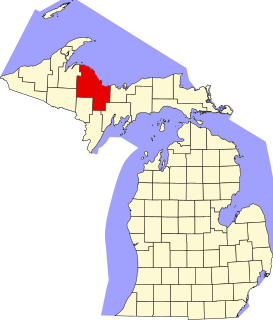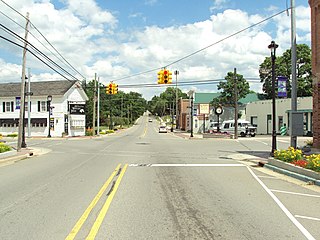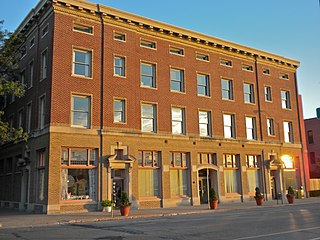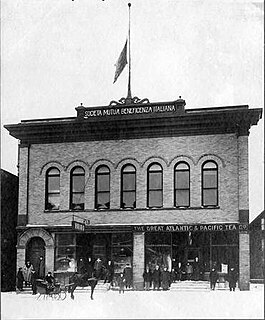
Hancock is a city in Houghton County in the U.S. state of Michigan. It is across the Keweenaw Waterway from the city of Houghton on the Keweenaw Peninsula. The population was 4,634 at the 2010 census. The Weather Channel has consistently ranked Hancock as the third-snowiest city in the U.S.
The following is a list of Registered Historic Places in Iron County, Michigan. The list includes 79 structures and historic districts that are significant for their architectural, historical, or industrial/economic importance.

There are 40 properties or districts on the National Register of Historic Places in Marquette County in the US state of Michigan. The locations of National Register properties and districts in Marquette County for which the latitude and longitude coordinates are included below, may be seen in a map.

The Cliffs Shaft Mine Museum is a former iron mine, now a heritage museum, located on Euclid Street between Lakeshore Drive and Spruce Street in Ishpeming, Michigan. The museum, operated by "Marquette Range Iron Mining Heritage Theme Park Inc.", celebrates the history of the Marquette Iron Range. The site was designated a state of Michigan historic site in 1973 and placed on the National Register of Historic Places in 1992.

The Marquette Iron Range is a deposit of iron ore located in Marquette County, Michigan in the United States. The towns of Ishpeming and Negaunee developed as a result of mining this deposit. A smaller counterpart of Minnesota's Mesabi Range, this is one of two iron ranges in the Lake Superior basin that are in active production as of 2018. The iron ore of the Marquette Range has been mined continuously from 1847 until the present day. Marquette Iron Range is the deposit's popular and commercial name; it is also known to geologists as the Negaunee Iron Formation.

The Calumet and Hecla Industrial District is a historic district located in Calumet, Michigan and roughly bounded by Hecla & Torch Lake Railroad tracks, Calumet Avenue, Mine and Depot Streets. The district contains structures associated with the copper mines worked by the Calumet and Hecla Mining Company, located along a line above the copper lode, where railroad tracks connected separate mine heads. The Historic District is completely contained in the Calumet Historic District and the Keweenaw National Historical Park. It was designated a Michigan State Historic Site in 1973 and was listed on the National Register of Historic Places in 1974.

The Savings Bank Building is a commercial building located at 101 South Front Street in Marquette, Michigan. It is also known as the Marquette County Savings Bank. The building was designated a Michigan State Historic Site in 1976 and listed on the National Register of Historic Places in 1978.

The Harlow Block is a commercial building located at 100 West Washington Street in Marquette, Michigan. It was listed on the National Register of Historic Places in 1983.

The Arch and Ridge Streets Historic District is a historic district located in Marquette, Michigan, running along Arch and Ridge Streets from Front Street to Lake Superior. It was listed on the National Register of Historic Places in 1980. The district includes the Call House.

The Call House is a private residence located at 450 East Ridge Street in the Arch and Ridge Streets Historic District in Marquette, Michigan. The house is also known as the Henry R. and Mary Hewitt Mather House. It was designated a Michigan State Historic Site in 1971 and listed on the National Register of Historic Places in 1972.

The Mather Inn is a hotel in Ishpeming, Michigan. The inn served as housing for the cast of the classic 1959 movie Anatomy of a Murder, and was the place where Duke Ellington composed the movie's score. It was designated a Michigan State Historic Site in 1976 and listed on the National Register of Historic Places in 1978.

The Metamora Crossroads Historic District is a historic district centered at the intersection of Oak and High Street in the small village of Metamora in Metamora Township in Lapeer County, Michigan. It was designated as a Michigan State Historic Site and also added to the National Register of Historic Places on July 19, 1984.

The Northwestern Hotel is an historic building located in the East Village of Des Moines, Iowa, United States. It was listed on the National Register of Historic Places in 1984.

The Iron County MRA is a Multiple Resource Area addition to the National Register of Historic Places, which includes 72 separate structures and historic districts within Iron County, Michigan, United States of America. These properties were identified and placed on the Register in 1983, with the exception of one property that was placed on the Register in 1993.
The Breitung Hotel, named for Edward Breitung, was a hotel at 111 South Pioneer Avenue in Negaunee, Michigan. The hotel, designed by David M. Harteau, was built from 1879 to 1880. The building was listed as a Michigan State Historic Site on June 20, 1985.

Italian Hall was a two-story commercial and recreational building in Calumet, Michigan, built in 1908 and demolished in 1984. Two prior buildings known popularly as "Italian Hall" had stood on the site. The first floor housed commercial space with a large hall on the second floor. The building served as headquarters for the Società Mutua Beneficenza Italiana and hosted community events. The hall is notorious as the site of a disaster in 1913 in which over 70 people died after a false cry of "fire" at a Christmas party. Since demolition, the site has served as a memorial park. The property is a Michigan State Historic Site and the building was formerly on the National Register of Historic Places.

The Chelsea Commercial Historic District is a historic district located along both sides of Main Street from Orchard to North Street in Chelsea, Michigan; the district also includes the adjacent 100 blocks of Jackson, East Middle, and West Middle Streets, as well as structures on Park, East, and Orchard Streets. It was listed on the National Register of Historic Places in 2011.

Louis Graveraet Kaufman was an American business executive and businessman. He was named president of First National Bank of Marquette in Marquette, Michigan in 1906. In 1910 he became the president of Chatham National Bank of New York, also remaining president of First National. Under Kaufman, Chatham National soon merged with Phenix National to form the Chatham Phenix National Bank and Trust Company. By the time Kaufman retired in 1932, the bank had increased 50-fold in size. Joining General Motors's board of directors in 1910, Kaufman remained on GM's board for 22 years, and was chairman of their finance committee.

The Ottawa Beach Historic District is a residential historic district located on Ottawa Beach Road in Park Township, Ottawa County, Michigan near the outlet of Lake Macatawa. It was listed on the National Register of Historic Places in 1995.




















